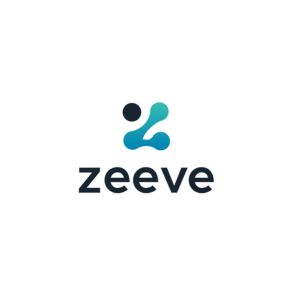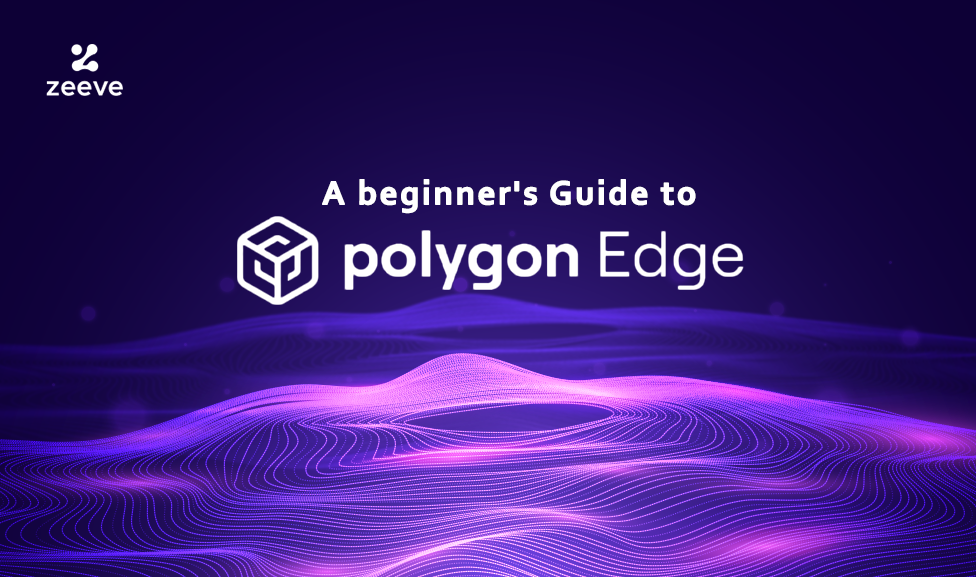A beginner’s guide to Polygon Edge
 Zeeve
Zeeve
Industries are changing the nature of business by bringing blockchain technology into the frame. The tech stack has revolutionized every sector, from logistics to gaming and finance to healthcare. This was possible because of smart contract technology powered by Ethereum, which enabled digital ownership for users.
NFTs and DeFi are the two finely created products of smart contracts that opened the path to a decentralized form of the internet - Web3. Although Ethereum is a widely used blockchain for smart contract deployment, it also brought scalability issues for mass usage. It led to the introduction of newer platforms like Polygon to bring scaling solutions for developers who wish to deploy scalable applications with low fees.
But the future of Web3 cannot be determined by a single blockchain. It needs to hinge upon an internet of blockchains that will interoperate in one way or another. This blog will uncover the basics of Polygon and its scaling solution - Polygon Edge. Let's get started.
Polygon - Decentralized Ethereum Scaling Platform
Bitcoin and Ethereum are two blockchain networks that came to foster decentralization. These networks started replicating traditional financial offerings to enable people to access its vast offerings, such as NFT marketplaces, P2E games, predictive and betting markets, insurance, and exchanges.
However, the popularity led developers to think of an alternate solution because of the enormous gas fees and high transaction time. Developers saw this as an opportunity to introduce Polygon for building scalable, user-friendly DApps with enhanced security, scalability, and better developer experience.
Polygon was co-founded in 2017 by four developers: Sandeep Nailwal, Jaynti Kanani, Anurag Arjun, and Mihailo Bjelic. The platform came into the limelight soon after its launch and bagged funding from prominent VC firms such as Sequoia Capital India, Galaxy Digital, SoftBank, and Galaxy Interactive.
According to the website, 'Polygon is a decentralized Ethereum scaling platform that enables developers to build scalable user-friendly DApps with low transaction fees without ever sacrificing on security.' At present, Polygon has saved over $140M of daily gas, processed over 1.8 billion transactions, and interacted with more than 135M unique addresses.
How does Polygon work?
Polygon is a Proof-of-Stake (PoS) blockchain that has fostered an L2 network for building interoperable, Ethereum-viable blockchain networks. Being a PoS blockchain, it creates a fast parallel blockchain linking it to the Ethereum blockchain. Proof-of-Stake blockchains are more scalable for adoption among the masses. Recently, even Ethereum transitioned from PoW to PoS blockchain.
While PoW blockchains have miners that validate the transactions, PoS blockchains possess validators that verify transactions to receive rewards in native tokens. Developers building on Polygon can send preset blockchain networks quickly due to its flexibility. Polygon also simplifies the process of cooperation between two blockchains.
Validators: Validators help verify the transactions for adding them to the blockchain by running full nodes to rewards in the form of fees. However, becoming a validator requires sheer dedication to run a full-time node.
Delegators: Delegators do not stake their tokens directly but operate a trusted validator. But users must approach it cautiously as a malicious validator can lead to loss of funds or staked MATIC.
Polygon has already developed several scalability methods that have their own advantages and disadvantages. Standard scaling solutions of Polygon include Polygon PoS, Polygon Nightfall, Polygon Edge, and Polygon Supernets. Next in line, we will read about Polygon Edge and what it offers.
What is Polygon Edge?
Polygon Edge is a flexible and extensible framework for creating Ethereum-compatible blockchain networks. It is the latest blockchain framework powered by Polygon that allows you to create an Ethereum-compatible blockchain network quickly.
An attractive quality of Polygon Edge is the compatibility with Ethereum smart contracts to create blockchain networks with customizable features. The scaling solution is popular for its modular architecture, extensibility, efficiency in bridging public to permissioned networks, and the benefit of low gas fees.
Polygon Edge empowers developers to create DApps by developing plugins rather than forking. It also offers several custom features to users, including a developer-friendly plugin system, the ability to change the main functionalities with Consensus plugins, and going beyond Ethereum's smart contracts with Runtime plugins.
Istanbul Byzantine Fault Tolerant (IBFT)
Polygon Edge makes use of a unique consensus mechanism - IBFT, which supports two forms: PoA (Proof-of-authority) and PoS (Proof-of-Stake). The solution enables the transfer of tokens such as ERC-20 and ERC-721 via a centralized bridging solution. It also supports communication across a myriad of varied blockchain networks.
JSON-RPC endpoints are the mediator for industry-standard wallets to interact with the Polygon Edge. It allows the node operators to perform actions on the nodes through the gRPC protocol.
Proof-of-Authority (PoA)
Proof-of-Authority (PoA) acts as the default consensus mechanism, where validators are responsible for creating and adding blocks to the blockchain. The validators form a dynamic validator set, where a voting mechanism enables adding or removing the validators from the set.
Hence, validators can be terminated/added from the set if the majority (51%) of the nodes vote to drop/add a particular validator. The process helps identify and remove the malicious validators from the network while the ecosystem can add new trusted validators.
Next, the validators take turns to propose the following block (round-robin). But, a supermajority (more than 2/3) of the validators is required for the block to be validated.
Proof-of-Stake (PoS)
The proof-of-stake (PoS) consensus mechanism is an alternative to the IBFT PoA, allowing node operators to select among the two consensus mechanisms before beginning a chain. Epochs are the notable introduction of Polygon Edge for PoS, representing a unique time frame in which a specific group of validators can create blocks.
Node operators can change an epoch length during genesis generation to suit their needs. During the realization of each epoch, it revises the validator sets, while during the design of the epoch block, nodes query the validator set.
The process ensures that the Staking Smart Contract has complete control over the addresses in the validator set. The only obligation of nodes is to query the contract for bringing the current validator set data one time during an epoch. This removes the burden of separate nodes from keeping an eye on validator sets.
BLS
BLS is a signature scheme to provide enhanced security in the IBFT consensus mechanism. It can cluster multiple signatures into a single-byte array to decrease the size of the block header. Node operators can use BLS in their chain, but the ECDSA key is used in any state (on/off) of BLS.
Modules by Polygon Edge
Polygon Edge offers several modules to the developers so they can customize them depending on their needs. Let's read about them.
Blockchain: It represents the blockchain layer responsible for coordinating everything in the Polygon Edge system.
State: This layer contains the state transition logic and deals with the state change process.
Consensus: It is a module that provides developers with IBFT Proof-of-Authority or Proof-of-Stake consensus engines.
Libp2p: It is fast, flexible, and extensible, providing the ground for the principal network layer.
Networking (GRPC): It is an essential layer that handles operator interactions. This layer is keen on running the transmissions between nodes on the chain.
JSON RPC: It is an API layer developers use to establish communication with the blockchain.
TxPool: It depicts the transaction pool, which pools the transactions from multiple system points.
Minimal: It acts as a primary hub for all the services on Polygon Edge.
Apart from this, Storage, Types, Syncer, Sealer, etc., are other modules in the plugin system that developers can use to build standalone chains for their specific use cases. Polygon Edge has also introduced a solution for facilitating cross-chain communication. It is a trustless and decentralized built-in Ethereum Bridge that enables the seamless transfer of NFTs or ERC-20 tokens from any Substrate or Ethereum Virtual Machine compatible network.
What are the advantages and disadvantages of Polygon Edge?
Polygon Edge is an EVM-compatible scaling solution that permits developers to carry Ethereum smart contracts straight to their chain. It enables developers to build DApps, create NFTs, or even make blockchain games, all compatible with Ethereum.
Polygon Edge has the JSON-RPC module, allowing users to commune with these blockchains via industry-standard wallets. It helps to enhance the user experience as users can keep the tokens on popular wallets with better security measures. The solution also empowers seamless switching between IBFT PoA and PoS consensus without resetting the chain.
Edge also delivers mobile code using Solidity/Vyper programming language, which developers look up to for writing the code. The scaling solution also includes customization features for developers where they can change core features. Polygon Edge offers access to much-loved Ethereum libraries, tooling, and development tools.
Although Polygon Edge is a Layer-2 solution, it is not entirely autonomous and relies on Ethereum. Another con of using Polygon Edge is that developers need to possess some technical knowledge and experience in EVM.
.png)
About Zeeve
Zeeve is a one-stop place for deploying the Polygon Edge network using the enterprise-grade Zeeve platform. We provide end-to-end reliable, secure, and scalable services for deploying, monitoring, and scaling nodes.
Developers can harness the Zeeve platform to deploy the Polygon Edge network with wizard-based genesis configuration and runtime upgrades with parachain. Zeeve enables users to access the GUI dashboard, CICD automation, cross-cloud deployments, enterprise-grade uptime, and node monitoring.
Zeeve supports all vital cloud providers with VM based native orchestration strategy. It also enables developers to bring their own cloud or use Zeeve Managed Service deployment options for the Polygon Edge network. Additionally, we provide detailed cloud monitoring to maintain the uptime of your Parachain infrastructure.
Zeeve has the trust of over 12000 blockchain startups, developers, and enterprises for their Blockchain deployments. We support the custom configurations for your Polygon Edge network, including validator and genesis configs, tokenomics, and customizing the bridge functionality using Bridge plugins. Sign up now.
Subscribe to my newsletter
Read articles from Zeeve directly inside your inbox. Subscribe to the newsletter, and don't miss out.
Written by

Zeeve
Zeeve
Zeeve is an enterprise-grade low-code Blockchain Infrastructure-as-a-Service platform, compliant with ISO 27001, SOC2 Type II, and GDPR standards. We are the leading provider of Rollups-as-a-Service, dedicated node infrastructure, and hosted subgraphs. All the infrastructure managed by Zeeve includes 24x7 monitoring, Enterprise SLA, 99.9% uptime guarantee, and management dashboards to ensure a secure and scalable infrastructure. With support for all major Blockchains, 27,000+ platform users, and 40+ enterprise clients, Zeeve stands tall as the global go-to provider for Web3 infrastructure.